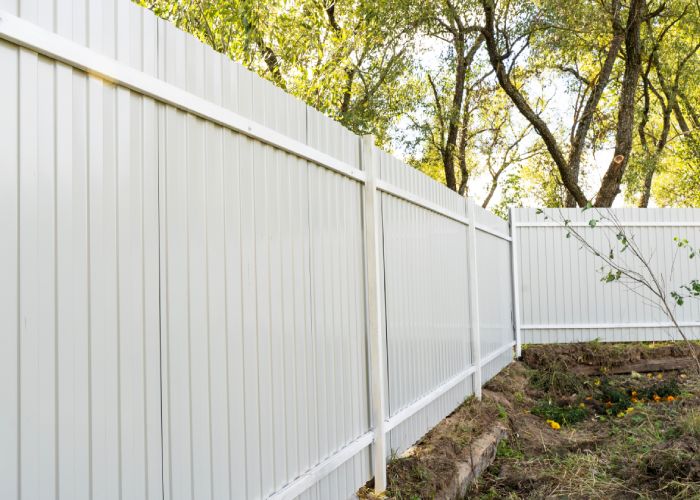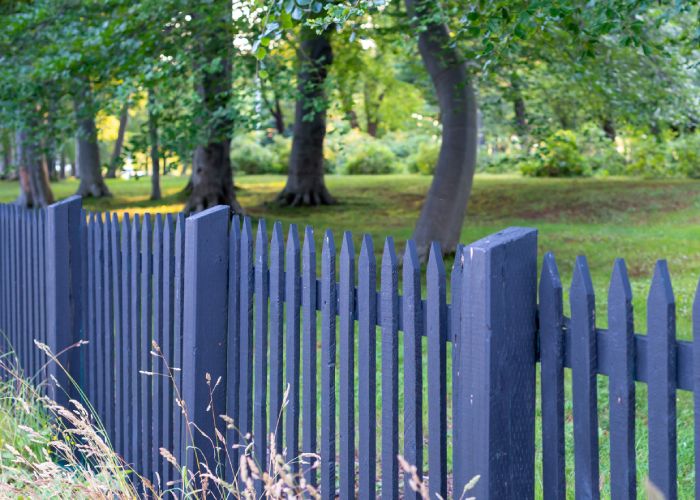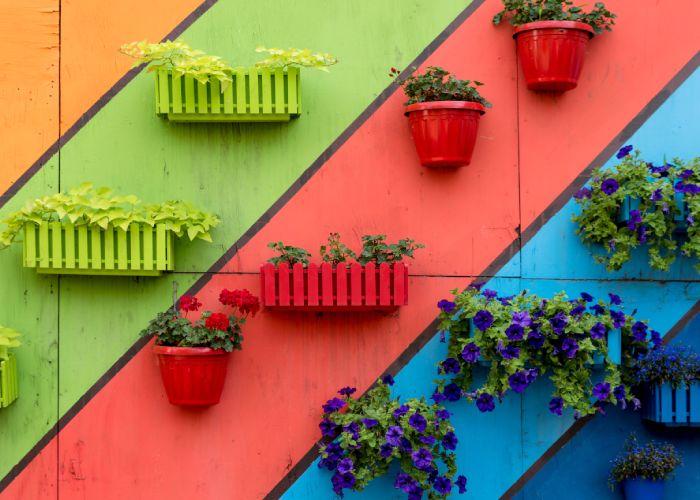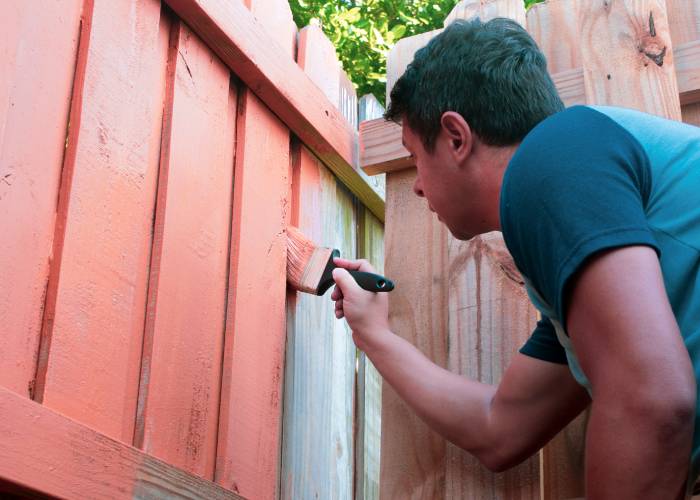Transforming the apparent size of your garden starts with the frame around it – the fence! Fence painting can breathe new life into a space, but as odd as it sounds, choosing the right colour can impact your garden’s size.
Consider the tips described below if you want to improve your garden in spring or spruce it up for a looming home sale. That way, you’ll impress visitors and potential buyers alike with a garden that looks larger than it really is.
So, which colours actually make your garden feel bigger? This depends upon the overall aesthetic of your garden and the look you want to achieve – so we outline the best options from across the colour spectrum.

1 Light and Bright Colours
When maximising perceived size, light and bright colours are great options. Light hues usually reflect more light, visually pushing the boundaries of your garden outwards. Consider it the same approach as the chalk-white Greek and Mediterranean homes that reflect the sun.
- Cream: A classic and versatile choice, cream offers a timeless elegance while reflecting ample light. It pairs brilliantly with almost all garden styles and complements diverse planting schemes.
- Pale Yellow: Infuse your garden with sunshine using light yellow paint. This is a more cheerful hue, creating a warm, inviting atmosphere and making the space feel airier.
- Soft White: A clean and crisp option, soft white reflects even more light than cream, creating a sense of openness and spaciousness. Remember, opt for a “soft” white to avoid a sterile feel. Fortunately, this colour avoids the slightly old or quaint look associated with cream paint.
- Light Blue: Light blue paint is a calming colour reminiscent of the sky and pairs well with lush greenery. Again, it pairs well with the garden habitat as a natural colour.
- Pale Green: Choose pale green paint to create an obvious connection with nature. This refreshing hue seamlessly blends with your garden foliage, visually expanding the boundaries outwards and upwards.
TIP: Check out these fence paints on Amazon UK

2 Neutral colours
Neutral colours are a subtle approach to engineering a garden that feels spacious. They provide a clean canvas for your garden’s most vibrant flowers and features to shine while still signalling space and openness. You must be picky when selecting paint to achieve the intended effects, as cheap paints may dry in undesired hues.
- Light Grey: A versatile option, light grey paint hints at sophistication while reflecting light effectively. It pairs well with various garden styles, allowing plants and flowers to take centre stage. Ensure the grey you choose is light to avoid an ‘industrial’ and dull appearance.
- Beige: As a warm and inviting neutral colour, beige creates a cosy atmosphere while indicating spaciousness. It complements many gardens, but make sure the hue is not too dark or bright.
- Taupe: Offering a touch more warmth than beige, taupe is an earthy colour which adds depth and dimension while still reflecting light. This colour pairs well with various planting schemes and suits the natural environment.

3 Dark Colours
The risky option! The less neutral the colours you choose, the more careful you’ll have to be when assessing your garden and the paint you use. Dark colours without the necessary pigmentation will make your garden look drab, imposing and boxed in.
However, strategically using darker hues can create a striking and elegant statement without restricting your garden’s apparent space.
- Dark Grey (charcoal): A bold and modern choice, charcoal grey can add a touch of sophistication to your garden. However, use it sparingly on accent walls or specific fence sections to avoid overwhelming the space or making a pure black fence! Too many people cover their homes in this colour, only for them to seem restricting and ‘overcast’.
- Deep Blue: Create a sense of intrigue with deep blue paint. While it can visually recede, use it on a single fence section to create a focal point without diminishing the overall size perception. It has the advantage of being a natural colour, so it does not look too out of place.
- Forest Green: Embrace the natural world with a deep, forest green paint. This rich hue can add depth and complement your greenery. Out of the dark colours, it’s one of the safest, naturally pairing with the outdoor space without appearing to box in your garden space.

Unique & Interesting Paint Schemes:
So, we’ve explored the traditional options – but you may want to consider these unique colours and effects to make your garden space stand out.
- Ombre Effect: Create a gradual transition from light to dark colours, starting with a lighter shade at the top and deepening towards the bottom. This visually pushes the fence line upwards, making the garden appear taller.
- Horizontal Stripes: While a risky option, fence colours with alternating horizontal stripes is one way to increase perceived space. This can engineer a sense of breadth and visually expand the space using light colours for broad stripes.
- Geometric Patterns: You can even create geometric shapes and patterns in light and neutral colours. This should add visual interest while breaking up the monotony of a long fence, making the space feel less confined and regimented.
Important points to remember:
- Consider the garden’s size, shape, orientation, etc.: Choose colours that complement these factors. For example, if your garden is long and narrow, opt for horizontal stripes or light colours on long sides to create the illusion of width.
- Think about the style of your garden: Choose colours that harmonise with your existing landscaping and planting schemes. For example, you could consider specific colours which pair well with red-leaf colours or bright cornflower patches.
- Try samples: Before committing to an entire paint job, you really should test colours on small sections of your fence to see how they look in your specific lighting conditions – no matter how confident you are!
- Get advice: If you’re unsure about which colour to choose, consult painters, garden designers, friends, family – and perhaps especially your next-door neighbours!
Further tips to improve your fence paint colour:
- Remember the power of contrast: While light and neutral colours generally make a space feel larger, strategically placed darker accents can add depth and dimension, stopping the garden from feeling flat. For example, you could paint fence posts or gate details in a darker shade to amplify this effect.
- Think beyond paint: Consider utilising multiple elements to create a spacious feel, like using mirrors strategically to reflect light and create depth or planting tall, slender trees and shrubs to draw eyes upwards.
- Embrace natural light: Ensure your garden receives as much natural light as possible by trimming overgrown trees and shrubs and keeping windows and doors clear. This will naturally brighten the space and contribute to a more expansive feel.
- Pick a good paint: this is really important. Pick a trusted brand with the required pigment count, durability and thickness.
In conclusion
Take your time with your paint job, even if your garden feels small and boxed in. Using a considered approach, you can engineer a colour scheme that plays on the best parts of your garden, leading to a spacious ambience and high-end finish.





